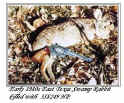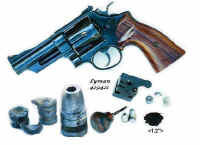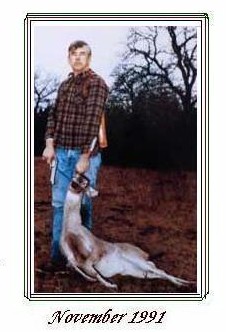The Keith Designed Cast Hollow Point Revolver Bullets
by
(Click on any of the thumbnail images for a larger photo.)
The bullets designed by Keith, Croft and their associates between 1928-31 continue as a staple among revolver enthusiasts. The later years of that period saw versions in hollow based and hollow point form. The hollow-point .38 and .44 bullets were, for several decades, the most popular variation on the basic theme. Keith regarded them as useful on large game when great penetration was not needed and found them extremely effective on the small species even with less than ideal placement.
Over the decades, his recorded observations on the performance of these bullets were validated over and over again. Keith reported that the bullets would expand reliably at 1,000 fps when cast of a reasonable lead /tin alloy. He reported that the 358429 over a " heavy" powder charge was the only .38 caliber load he had found that would drop a paunch -shot porcupine, dead at the shot.
In the 1960’s Texas gun writer, Gene West reported the same results. He was loading the 429 over 15 grains of 2400 for his 6" Highway patrolman. West preferred to cast his bullets from wheel weight metal observing that the nose would scatter fragments throughout the varmint while the portion of the base below the hollow point would achieve deep penetration.
By the late 1950s, various companies were attempting to improve handgun bullet expansion by experimenting with pure lead cores swaged into half to ¾ length cups or jackets. Speer listed loads for such bullets in the Number 3 Reloading Manual of 1959. These bullets generally took a backseat to cast lead in the accuracy department and the Keith Hollowpoint remained popular. By 1963, Jacketed Soft Point loads such as the 210 41 Magnum were being applied to magnum cartridges. In 1965 Winchester-Western anticipated later developments with a .44 Magnum Carbine load capped with a " Hollow Soft Point". By that time, the Speer ¾ jacket design had developed to the point that no soft lead came into contact with the handgun bore. Throughout the 1960s and early ‘70s, bullet design proceeded apace but jacketed handgun bullets that would perform reliable at 1,000 fps and below were still many years in the future.
In Waco, Texas in the years between 1960 and the early 70s, I, along with several other adolescent handgunners, got started in reloading through a symbiotic deal with a local policeman who ran a reloading business on the side. His Star Machine produce consisted of Wadcutter practice rounds loaded in mass for a number of area police departments. He also turned out a scattering of duty loads using the Thompson Gas check designs in both solid and Hollow Point variation and the Keith 358429 HP loaded over 5.7 Unique for the .38 Special. The deeply hollow pointed 155-158 grain Keith was, by far, the most popular. He produced them one at a time with a single cavity Lyman mold and the labor of his gaggle of Street Arabs who were afforded a 50-50 apportionment of the bullets.
The 5.7 Unique load was supposed to get you 1,000 fps in a .38. The local policemen considered this an ideal load and they continued to carry a few in their belt loops even after upgrading to .357 and the new soft- point loads. By the late ‘60s, a lot of policemen had switched to the magnum revolvers and the fitfully expanding 158 grain soft point rounds that had recently come into use in the stretch .38. The old Special load had been relegated to the task of dispatching stray dogs.
The Speer #3 would let you use 10.5 Hercules 2400 for a claimed 1060 fps from a.38 Military and Police or K38. Various sources would sanction15 grains of that propellant with the Keith bullet crimped into the front driving band in .357 cases. They were massively destructive in that particular venue. It is in the nature of teenagers to want to create the maximum amount of noise and damage and the later load in particular suited us to a tee. They would thoroughly rend any water filled container and pulped the insides of many an armadillo splitting their exoskeletons from Dan to Beersheba. They would tear a hole the size and shape of a church key point through one side of a steel army helmet that the sharp full jacketed factory AP loads would only dent. There would be a delta of lead streaks on the other side. With a small machine screw threaded into the hollow point, they would punch a round .38 caliber hole through both sides.
The more sedate .38 /10.5 2400 load became my staple field load for years to come. For several years, my only centerfire handgun was a 1959 vintage K38. Putting down a tough swamp rabbit or jack was dicey business with non- expanding bullets but the Keith Hollow point would anchor them reliably.
Throughout much of the 70s and 80s we were using 2400 and WW 630 loading the 429hp to velocities of 1150 fps or there about and observing dollar-sized exit holes on jack rabbits. The internal damage closely resembled what we were causing with 125 grain Jhp s moving several hundred feet per second faster. The .44 version of the Keith the 429421 driven to the same velocity range showed signs of full expansion on the same targets although the pulping of internal organs and exit wounds were often observed to be less extensive. Both bullets retain just over 1,000 fps velocity at 80 yards. We hit a couple of jackrabbits at that range with both calibers and observed that bullet expansion- true to the Keith observation, was still taking place. Long ago, I settled upon chilled shot as an alloy source for these bullets. They are somewhat tedious to cast but produce the same expansion characteristics as bullets cast from recovered jacketed bullets.
Neither the .38 nor .44 Keith Hollow Points show any substantial expansion in the 700-over 800 fps velocity range regardless of the target hit. On game and various expansion media, both expand reliably at impact velocities of just over 1,000 fps. Driven to 1350 fps, the .44s are likely to produce expansion, fragmentation and considerable penetration on live game. At 1500 + fps, the .44s have become virtual bombs and will blow a double fists sized hole through a thin rack of pork ribs. These bullets seem most useful when impact velocities run between 1,000 and 1300 fps or thereabout. They are particularly useful when you want full expansion at sub- maximum velocities ranging from 1,000 to 1200 fps.
In 1991, I took cover inside a cedar bush next to a game trail with my 5.5" Ruger Stainless Blackhawk .44. An old buck with stunted antlers stopped 30 yards from my hide and I shot him through the left shoulder with a 421 over 19.5 2400. This was a 1340 fps load from that revolver and clocked just under 12 from a 4" 29. The shoulder was shattered and the bullet proceeded through about 14" of chest muscle putting a 1" cavity all the way through the right shoulder blade. The deer crumpled to the ground unable to use either front leg. A second shot tore a 1.5" rend through both lungs causing the deer to drop its head and die instantly. I found the first bullet base and two nose fragments together under the skin on the far side. The bullet had started out weighing 235 grains and the recovered pieces totaled 165 grains. By contrast, a buck I shot through the lungs with a solid version of this bullet ran 50 yards before lying down.
Capturing the bullets in various media demonstrates several consistent findings:
Shot through four to eight inches of flesh (beef brisket) prior to passing through a foam-core /paper sheet, these bullets generally arrive at full expansion with no- or few separated nose fragments. The .44 signatures usually measure 90 caliber to just over an inch-as do those bullets that are recovered whole and mushroomed in the classic manner. The .358429s regularly reach sixty to over seventy caliber;
Fragmentation occurs most often when the bullets have fully penetrated the grocery store meat and enter water jugs or wet pack designed to stop them;
In animals weighing 20 to 40 pounds and upward, the base and fragments tend to travel together with a few sharp and jagged separate channels observed. These tend to occur when the bullet passes through tissue of different density.
There is no discernable difference in media performance at 25 and 50 yards.
The Keith Hollow Point molds have been out of production for two and perhaps three decades. At the height of their popularity, the molds were a bit hard to find and those surviving may now be regarded as relics of a bygone age. They have been superceded by new generations of jacketed bullets that perform much better than the jacketed bullets of just 20 years ago. They also have some competition in the form of commercial swaged lead hollow points which do not perform nearly as well as the original Keith designs. Several factors enter into the evanescence of the Keith hollow points. With the likely exception of the old Hollow Base designs, they represent the slowest and most tedious casting operation possible. The mold is single cavity with a bottom pin that has to be removed after each pour. Rejection rates can be high, as it is a bit difficult to get the hollow noses to fill out properly. Further, there is a body of literature- some of it from usually reliable sources- that says that the Keith Bullets will not expand. Many people accepted this as fact and avoided the hassle of casting them. Finally, with the plain based and relatively soft bullets, some degree of bore leading is to be expected. The practical consequences of this range from the need to apply a bore brush after every cylinder or so to practically nil depending on a number of factors that are difficult to pin down. In any case, it is not unusual to find that the 358429 and 429421 bullets, optimally loaded, produce groups that equal and exceed those obtained with jacketed bullets in the same revolver.
I have long wished that some commercial concern would bring out a mass produced lead hollow point that copied the Keith design in overall form and had the deep hollow point feature that makes them so effective. Instead, they have concentrated on producing jacketed bullets that expand usefully over the full range of handgun velocities. All-in-all, this is probably a good thing.
It occurs to me that my odyssey with the Keith Hollow Points is now ongoing for forty- one years. It has not been a solo journey by any means. It is an increasingly small world and perhaps you will recognize some of the players. Maybe they will happen across themselves and be gratified. All were inveterate casters, loaders and users of the Keith Hollow Points. All are steadfast friends and all have left firm footprints on the palimpsest of time. Their shared experiences greatly enhanced my own. Pretty much in the order of their appearance, they are:
Louis James Ellis, Waco, Texas- We turned out many an alloy bullet for area police departments. He had the first Ruger Flat Top on the block and used the first issue Speer 146 Gr. Hollowpoints to explode railway pigeons and nutria-rats.
John Edgar Thorne circa 1920-1998. Sergeant Waco Police Department and Custom Reloader.-He taught us how while passing on the lore of Kent Bellah, Ron Power and others.
Dr. Richard K. Gunn , Newport News , Virginia USN Vietnam, USAMC Germany. He ran many a 429 through the Star Lubri-sizer.
James Miles Pickens 1946- 1994 Waco, Texas; FT Payne Alabama, Life Member NRA- Custom Handloader, Class III Dealer and encyclopedia of ordinary and arcane firearms knowledge.
Jim Stacy Albuquerque, New Mexico. An inveterate explorer of the various loadings of the Keith bullets and their effects upon animate targets.
since the website crashed AUG 2003






